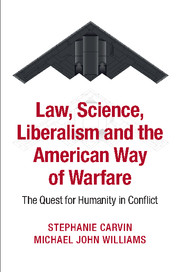Book contents
- Frontmatter
- Contents
- Prologue
- Introduction
- 1 Law and science in the Western way of war
- 2 The American way of war
- 3 Vietnam and the “science” of war
- 4 Immaculate destruction: reorganization, revolution and re-enchantment of War
- 5 Revolution denied: the “war” on terror
- 6 Back to the future?
- Index
- References
4 - Immaculate destruction: reorganization, revolution and re-enchantment of War
Published online by Cambridge University Press: 05 December 2014
- Frontmatter
- Contents
- Prologue
- Introduction
- 1 Law and science in the Western way of war
- 2 The American way of war
- 3 Vietnam and the “science” of war
- 4 Immaculate destruction: reorganization, revolution and re-enchantment of War
- 5 Revolution denied: the “war” on terror
- 6 Back to the future?
- Index
- References
Summary
Our strategy to go after this army is very, very simple. First we’re going to cut it off, and then we’re going to kill it.
Colin Powell, January 1991The defeat in Vietnam, it can be fairly said, was an outcome that the US military essentially would choose to forget in the 1970s and 1980s. Abandoning the difficult lessons of irregular warfare and counterinsurgency in the jungles and deltas of Southeast Asia, American military leaders and service chiefs instead wanted to return to “proper,” conventional warfare that, in their minds, would be fought in Cold War Europe against the USSR. Further, frustrated with what they saw as interference by civilian “Whiz Kids” during the war, military leaders sought to reform civil–military relations as they changed from a conscripted to a professional force. However, there were other lessons of Vietnam that could not be ignored: the mistakes and errors caused by service infighting, a poor chain of command and weak military advice would continue to affect US military operations into the 1980s. Future US military operations were clearly in jeopardy unless urgent reforms to the Department of Defense were undertaken, despite objections from the military establishment. Although the reforms mandated by Congress were not always welcome, they transformed the US military into a much more efficient and effective military force. The 1991 Gulf War demonstrated the effectiveness of these reforms as the armed forces seamlessly blended superior military technology, law and their new, streamlined command structure into a lethal fighting force that utterly annihilated the Iraqi Army. Finally, it seemed, the US military had achieved a balance between annihilation and restraint in a perfect liberal war.
- Type
- Chapter
- Information
- Law, Science, Liberalism and the American Way of WarfareThe Quest for Humanity in Conflict, pp. 120 - 156Publisher: Cambridge University PressPrint publication year: 2014



